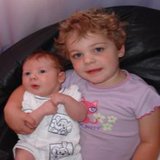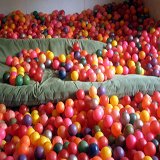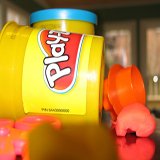Language Development Activities
8 Easy and Fun Ways to Improve
Baby Language
Development
The other day a mom contacted me with the following question about language development activities: "My baby is four months old. She loves life and coos with delight when she is happy or sees something she wants.
I know it will be a while before she says her first word, but are there any activities regarding baby language development, I can use to encourage her verbal communication skills while playing with her?"
Well, I've researched language development activities for children and would like to present the answer here as I think every mom could use these language development activities to improve baby language development.
You are absolutely right that even the youngest babies are learning language through various informal language development activities. Long before they learn to speak, babies get sold on communication. The more you listen and respond to your baby, the better (s)he will become at communicating with you.
Already, you have learned to interpret your babys various sounds of delight or desire. You probably have also begun to decode her many cries. As you listen, watch and learn from your past experience with her, you will get better and better at reading her verbal and non-verbal communication.
Baby reaction time is slower than that of adults, however. Listening to her means that you may need to slow down and wait for her communication. If you cant understand everything your baby "says," dont worry.
No parent can understand every cry and coo their baby makes.
However, two things happen when you listen attentively and try to figure out your babys message. First, your baby has the experience of someone being interested in her ideas and feelings. Secondly, through listening over time and trial and error, you eventually do figure out most of childrens cues.
Here are some baby language development activities you can do to support infant language development as well as toddler language development:
- Respond to your babys cries.
Babies also learn about communication through crying.
In the first year, crying is a central part of their communication system. When we respond to their cries, our babies learn that they will be listened to and that the world is a safe place where their needs will be met.
- Have "conversations" with your baby.
Young babies begin the skills of conversing by "taking turns."
They coo, look at you and wait. You coo and they coo back. In that simple interaction, they practice the structure of conversation and they learn that they will be responded to when they reach out to communicate.
- Talk naturally with your baby throughout your time with her.
Babies learn receptive language skills long before they learn expressive ones.
Your daughter will understand what you are saying to her well before she is able to speak many words. When babies grow up in a language- rich environment, they naturally development the skill of how to learn language. When you regularly talk to your daughter and listen to her, she will readily start to learn baby language. Modeling language is your best teaching tool. Babies and children dont have to be "made" to speak correctly. When you model correct language, they will gradually learn proper grammar.
- Extend her language and describe what you see her doing.
This is something parents instinctively do with children. When your baby reaches for your nose, cooing, you can say, "Thats my nose. Are you going to grab it with your little hand?"
When she turns toward the sound of the door opening, you can say, "You heard the door opening. Is that your sister coming in?"
When the cat approaches and she starts gurgling and kicking her feet, you can say, "Ohhh, you see Tiger coming. You look excited to see your fuzzy cat," or "Hi Tiger cat. Lisa is excited to see you coming."
- Talk to your baby about what you are doing with her.
It can feel awkward to talk to a baby who doesnt understand you, but she needs the repeated experience of hearing you talk in order to understand your language.
Before you pick her up, you can reach your hands towards her and say, "Im going to pick you." In this way she learns language in the rich context of experience.
During diapering you can say, "Here is your dry diaper. Im lifting up your bottom so I put it on you."
This not only helps her learn language, it also helps her learn to expect what will come next and participate more actively in the process.
- Talk about your own actions as well.
Engaging in self-talk around your baby teaches her language and helps her make sense of the world.
Describe what youre doing as you do it: "Im steaming these carrots for your lunch. Then, Ill grind them up and you can eat them." "Im going into the other room to get your blanket." "Im getting dressed and then Im going to change you." "Im going to go to work. Dad will stay with you today."
- Sing songs or tell her stories.
Songs and stories are an important part of learning language. Because they are repeated, children have a chance to learn them over time.
Songs, finger plays or movement activities teach children words that have physical clues attached. When a baby has learned a clapping song, she can ask for it by clapping her hands, even before she knows how to say, "I want to sing the clapping song!"
- Read books.
There are wonderful baby books available. Look for books with photos or aesthetically-pleasing pictures.
Children dont need cartoons as their only pictures. Also, look for books with rich, varied or poetic language.
Some babies will lie on their backs with you on the floor looking up at a book for several minutes at a time. Others will wiggle and squirm.
There is no magic age to begin reading to children. It should be as soon as they can enjoy it. Try it periodically to see if your baby is interested.
You can also make books for your child, using photos of familiar objects and people, mount them on little cardboard (poster board) pages and put them together with string or loose leaf rings. You can cover them with plastic (sticky cover or plastic sleeves) to protect them from drool and teeth.
Be sure to browse through all the baby language development pages for more language development activities.
Find It!
Can't remember where you read something specific? Just type in your search term in the box below and your specific topic will be returned to you instantly.









